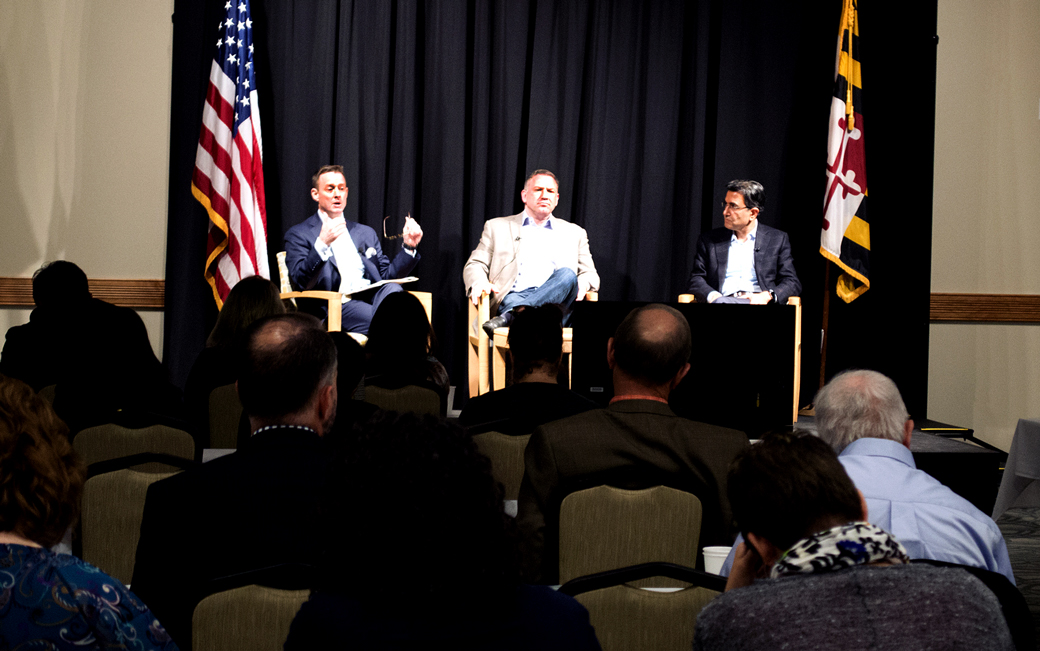Economic Outlook Forum goes inside TU’s Placemaking Strategy
Along with Maryland’s Economic Forecast, RESI also highlights Towson University’s future.

"Thriving together, not just coexisting together."
That was the key message on Wednesday morning, as Towson University and the Regional Economic Studies Institute hosted its annual Economic Outlook Forum inside the West Village Commons Ballrooms.
Along with sharing RESI’s Economic Forecast, the forum provided an inside look at the university’s new placemaking strategy. And in her opening remarks, Towson University president Kim Schatzel said it’s important for the university to extend its impact on the local community.
“We’re the largest university in the Greater Baltimore area and the second largest university in the state,” Schatzel said. “Towson University is really hot right now. We are a large and dynamic university and we take great pride in our influence in the community.”
Learn more about Towson University’s Placemaking & Anchor Strategy for Greater Baltimore
The highlight of the forum was a special presentation and question and answer session featuring the chief strategists for TU’s Placemaking and Anchor Strategy.
Both Ken Ulman, president of Margrave Strategies, and Omar Blaik, CEO of U3 Advisors, were on hand to show previous examples of their work, along with answering questions from both the Towson University and Greater Baltimore communities.
One of the main points of their presentation is to show how universities, along with hospitals, can be used as “economic engines” for the local communities. As an economic engine, Towson University could provide:
- A Center of Employment
- A Destination for Students
- Purchasers of Goods and Services
- National Centers of Research
- A Curator and Generator of Arts and Culture
- Owners of Real Estate
And while both Ulman and Blaik admitted that the university has a good foundation, there is a lot more that can be done to strengthen the connectivity with the surrounding community and emerging businesses.
“This is Towson’s time,” Ulman said. “There is a lot of early momentum. TU is doing well by being active in the community. And they have a great dynamic place with great sporting events, art and culture, and great retail.
“People want to live in cities. They are easy to walk through, they are fun to be around and there is a lot of retail. Towson and TU have the potential to be that. “
The university isn’t the only one excited about the future. Downtown Towson patrons and businesses are more than ready to take the next steps.
“I met with business owners this morning and they are fired up,” said Nancy Hafford, executive director for the Towson Chamber of Commerce. “With the leadership at the university, and the talent behind this study, we are more than ready for this to happen.”
Along with a look at TU and placemaking, the forum also saw the presentation of Maryland’s Economic Forecast which was presented by Daraius Irani, RESI’s chief economist.
Irani, who also is the Vice President of Innovation & Applied Research at TU, titled his presentation “Winter is Coming.” Using a phrase that means warning and vigilance seems to fit with the tumultuous year. But while 2016 was filled with unbelievable occurrences, Irani said that Maryland could see just a small slow down in 2017.
This includes less than one percent growth to the economy and growth in construction, health care, and professional scientific professions.
Irani noted that 17 percent of Maryland’s total output can be attributed to military installations. “With Maryland so dependent on the federal government and military spending, any changes that occur in these sectors during a Trump presidency could impact the state’s economy,” said Irani.
This story is one of several related to President Kim Schatzel's priorities for Towson University: BTU: Partnerships at Work for Greater Baltimore and Strategic Plan Alignment.